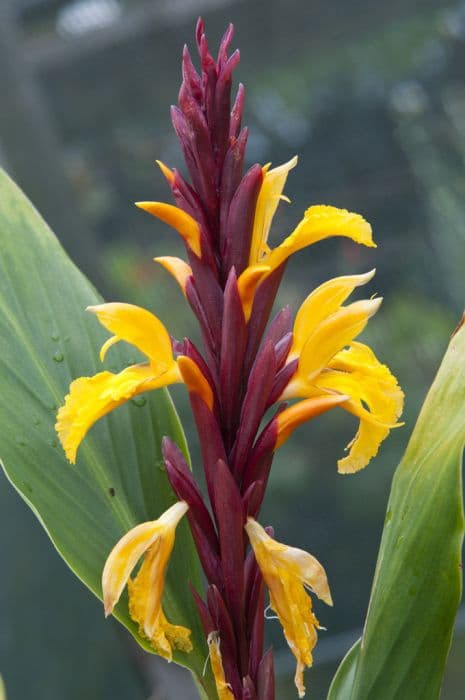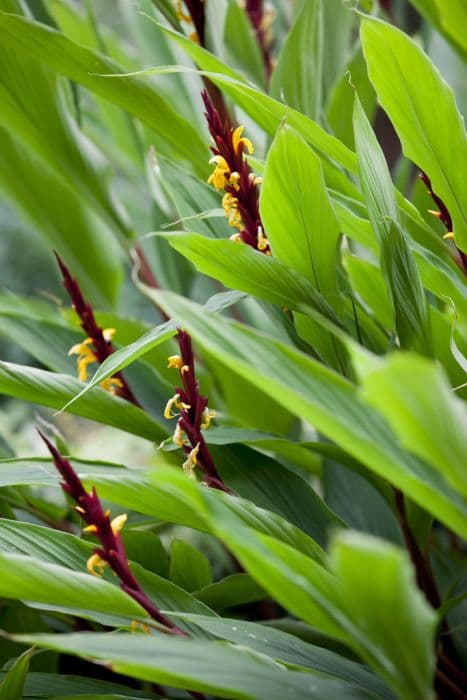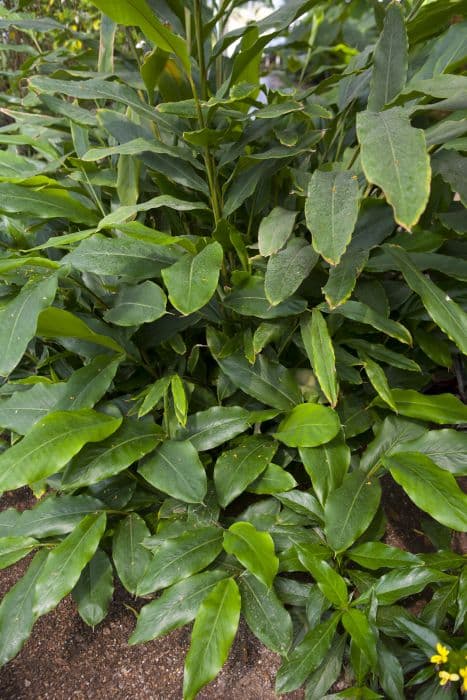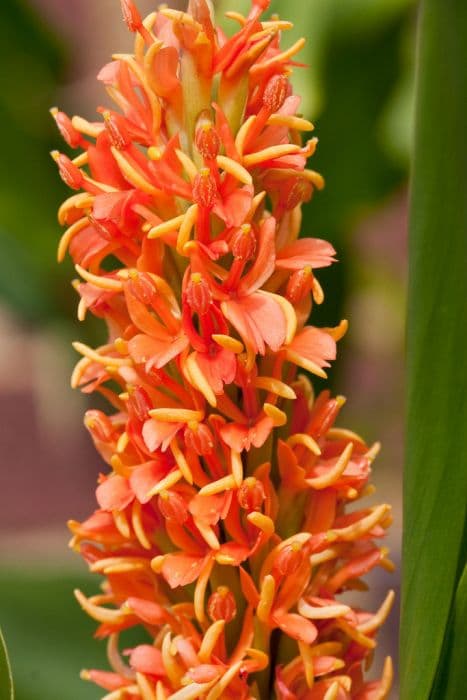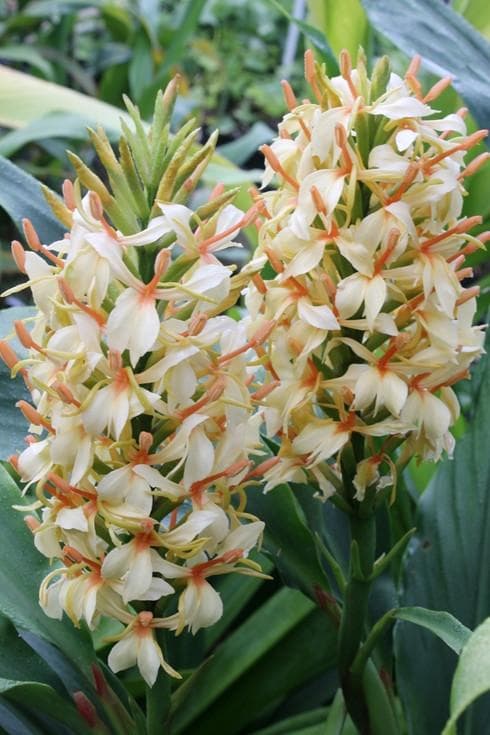Roscoea Roscoea humeana 'Stephanie Bloom'

ABOUT
Roscoea humeana 'Stephanie Bloom' is a visually striking member of the ginger family known for its ornamental qualities. The plant itself forms a clump of narrow leaves, which create a lush, green backdrop for the distinctive flowers. The leaves have a soft texture and a deep green color, which contrasts nicely with the blooms that appear in the warmer months. The flowers of 'Stephanie Bloom' are particularly elegant, often resembling small orchids. Each bloom emerges from a bract, which is a modified leaf that adds an extra layer of interest and color to the floral display. The flowers themselves have a delicate yet exotic allure, with petals that range in color from a soft purple to a more intense lavender or violet, often with intricate patterns. In the center of each flower, there are usually contrasting hues, with the stamen and pistil creating an attractive focal point. Some flowers may have a splash of yellow or white in the throat, which serves to draw in pollinators. The tubular shape of the blooms suggests an adaptation for such pollination interactions. This plant maintains a basal rosette form, meaning that the leaves and stems grow close to the ground, spreading outward from the center. This growth habit gives it a tidy appearance, making it an excellent choice for garden borders or as a focal point in a mixed bed. Overall, Roscoea humeana 'Stephanie Bloom' is valued for its exotic-looking blooms, lush foliage, and the striking contrast between the two, which creates a beautiful display in any garden setting. Its sophisticated appearance adds to the allure, making it a sought-after plant for garden enthusiasts.
About this plant
 Names
NamesFamily
Zingiberaceae
Synonyms
Stephanie Bloom Roscoea
Common names
Roscoea humeana 'Stephanie Bloom'.
 Toxicity
ToxicityTo humans
There is limited specific information available regarding the toxicity of Roscoea humeana 'Stephanie Bloom' to humans. Generally, Roscoea species are not known for being toxic, and there are no well-documented cases of poisoning from these plants. If you suspect poisoning, it is essential to seek medical advice.
To pets
Information about the toxicity of Roscoea humeana 'Stephanie Bloom' to pets is not widely documented. Roscoea species are not commonly listed as toxic to pets, but individual animals might have sensitivities. If your pet shows signs of illness after ingesting this plant, consult your veterinarian immediately.
 Characteristics
CharacteristicsLife cycle
Perennials
Foliage type
Deciduous
Color of leaves
Green
Flower color
Purple
Height
1-2 feet (0.3-0.6 meters)
Spread
0.5-1 feet (0.15-0.3 meters)
Plant type
Herb
Hardiness zones
6
Native area
Himalayas
Benefits
 General Benefits
General Benefits- Aesthetic Appeal: Adds vibrant colors and unique blossoms to gardens.
- Attracts Pollinators: Welcomes bees, butterflies, and other beneficial insects.
- Low Maintenance: Requires minimal care once established in the right conditions.
- Cold Hardy: Can withstand cooler temperatures, making it suitable for various climates.
- Perennial Growth: Returns year after year, providing long-term garden interest.
- Shade Tolerant: Thrives in partially shaded areas, offering flexibility in garden design.
- Container Gardening: Suitable for pots, making it ideal for balconies and small spaces.
- Soil Adaptability: Tolerates a range of soil types, though prefers well-drained conditions.
- Non-Invasive: Does not aggressively spread, allowing for controlled garden planning.
- Seasonal Interest: Offers a seasonal display with its late spring to summer flowering period.
 Medical Properties
Medical PropertiesThis plant is not used for medical purposes.
 Air-purifying Qualities
Air-purifying QualitiesThis plant is not specifically known for air purifying qualities.
 Other Uses
Other Uses- Roscoea root paste has been used traditionally to treat insect bites and stings, providing a natural remedy to reduce pain and swelling.
- The fleshy roots are sometimes used in the preparation of traditional Asian dishes, especially within hill tribes who value the plant for its flavor and purported nutritional benefits.
- The leaves of Roscoea may be used as a natural dye for fabrics, giving a mild green tint to the textiles it is applied to.
- In certain regions, fibers obtained from the leaves and stems of Roscoea are woven into mats or baskets due to their strength and durability.
- Roscoea flowers sometimes serve as an ornamental addition to salads or as a garnish, offering a unique aesthetic and slight floral flavor.
- These flowers have also been used in traditional ceremonies for decoration, symbolizing grace and a connection to the alpine regions where they thrive.
- The Rhizomes of Roscoea, while not commonly consumed, may serve as a starchy vegetable similar to ginger or potato in scarcity conditions.
- The plant plays a role in companion planting, attracting beneficial insects to gardens due to its bright flowers and unique scent.
- In homeopathy, diluted extracts from Roscoea have been used to prepare remedies that are considered to address certain emotional states, even though this is not scientifically proven.
- On a cosmetic front, Roscoea petals are sometimes infused in oils or creams, imparting their fragrance and being marketed for their exotic origins.
Interesting Facts
 Feng Shui
Feng ShuiThe Roscoea is not used in Feng Shui practice.
 Zodiac Sign Compitability
Zodiac Sign CompitabilityThe Roscoea is not used in astrology practice.
 Plant Symbolism
Plant Symbolism- Rarity: As a unique and relatively unknown plant, Roscoea humeana 'Stephanie Bloom' can symbolize something rare or exclusive.
- Beauty: The delicate and attractive flowers of this plant represent beauty and aesthetic appreciation.
- Resilience: Given that Roscoeas are hardy plants capable of thriving in challenging environments, they can symbolize strength and the ability to persevere through difficulties.
- Surprise: The sudden appearance of its flowers, which can be quite showy, may symbolize surprises and unexpected pleasure.
- Uniqueness: The specific cultivar 'Stephanie Bloom' with its distinctive characteristics can represent individuality and the value of being unique.
 Water
WaterThe Himalayan Ginger should be watered deeply and allowed to dry out between waterings to mimic its natural environment. Watering once a week with approximately one to two gallons, adjusting for climate and season, is generally sufficient. During the active growing season in spring and summer, you might need to water more frequently. In contrast, in the fall and winter during dormancy, you should reduce watering to prevent root rot. Always check the top inch of soil for dryness before watering.
 Light
LightHimalayan Ginger prefers partial shade with some morning sunlight and protection from the harsh afternoon sun. The best spot for the plant would be in a garden that gets filtered sunlight or a bright location with dappled shade. Avoid placing it in full sun, which can scorch the leaves, or deep shade where it might not flower as well.
 Temperature
TemperatureIdeal temperature conditions for the Himalayan Ginger range between 55 to 75 degrees Fahrenheit. It can tolerate a minimum temperature down to around 50 degrees Fahrenheit and a maximum of about 85 degrees Fahrenheit. These temperatures reflect the plant's preference for a cooler environment, similar to its native Himalayan habitat.
 Pruning
PruningPruning the Himalayan Ginger is mainly done to remove dead foliage, which can be cut back at the end of the growing season, and to maintain plant shape. Light pruning can be carried out in late winter or early spring. During the growing season, it can be beneficial to deadhead spent flowers to encourage more blooms.
 Cleaning
CleaningNot needed
 Soil
SoilRoscoea humeana 'Stephanie Bloom', commonly known as Himalayan Ginger, thrives in a soil mix that is rich, well-draining, and humusy with a pH ranging from 6.0 to 7.5. Incorporate organic matter such as leaf mold or compost for optimal growth.
 Repotting
RepottingHimalayan Ginger should be repotted every two to three years to replenish the soil and accommodate root growth. Overpotting can lead to water retention issues, so choose a pot that's appropriately sized for the plant's roots.
 Humidity & Misting
Humidity & MistingHimalayan Ginger prefers moderate humidity levels but is quite adaptable. Ensure it is not placed in overly dry conditions which can be common indoors, especially during winter heating seasons.
 Suitable locations
Suitable locationsIndoor
Provide bright indirect light, high humidity, and cool temps for Himalayan Ginger.
Outdoor
Ensure partial shade, rich soil, protect from harsh sun and wind for Himalayan Ginger.
Hardiness zone
6-9 USDA
 Life cycle
Life cycleRoscoea humeana 'Stephanie Bloom', commonly known as Ginger Fingers, begins its life cycle as a rhizome buried in well-drained soil; this stage is dormant, typically during the winter months. With the arrival of spring, new shoots emerge from the rhizome, leading to the vegetative growth phase, which includes the development of long, narrow leaves. As the plant matures, it enters the flowering stage in late spring or early summer, producing distinctive purple flowers that attract pollinators and enable sexual reproduction. Following pollination, the plant may produce small seed capsules if conditions are favorable. After seeding or throughout the growing season, the above-ground parts of the plant start to wither as it enters a period of senescence in late summer to autumn. Finally, the plant returns to dormancy, where the rhizome survives underground through the winter, ready to repeat the cycle in the following spring.
 Propogation
PropogationPropogation time
Spring-Early Summer
Roscoea humeana 'Stephanie Bloom', commonly known as Stephanie Bloom Roscoea, is generally propagated by dividing its rhizomes. The best time to propagate this plant is in the spring, just as new growth begins. To propagate by division, carefully lift the plant from the ground and gently separate the rhizomes, ensuring each section has at least one growth bud. Replant the divisions at the same depth they were growing before, spacing them about 12 inches (approximately 30 centimeters) apart to give them room to grow. Water the newly planted divisions well to help establish them. This method is straightforward and helps to maintain the specific characteristics of the 'Stephanie Bloom' cultivar.
